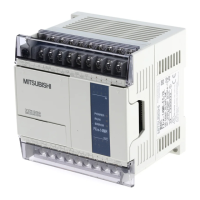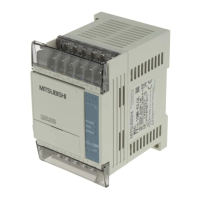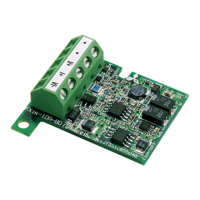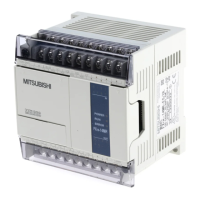
Do you have a question about the Mitsubishi FX1S Series and is the answer not in the manual?
| Model | FX1S Series |
|---|---|
| I/O Points | 10 to 30 points |
| Program Memory | 2000 steps |
| Power Supply | AC |
| Communication | RS-422 |
| Expansion | No expansion |
| Programming Language | Ladder Logic |
| Input Voltage | 100-240V AC |
| Built-in High-Speed Counter | Up to 60 kHz (single-phase) |
| Weight | Approx. 0.3 kg |
| Dimensions | 90 x 60 x 75 mm |
Explains the principles of ladder logic, contacts, coils, and how to interpret their operation.
Explains STL's operation as a flow chart system, organizing programs into states or steps for better manageability.
Covers the essential methods for starting and terminating STL programs, including embedded programs and activating new states.
Details the 'X' device mnemonic for physical inputs, its available forms, numbering, and example usage.
Explains the 'Y' device mnemonic for physical outputs, available forms, numbering, and provides a table of available devices.
Introduces the 'M' device mnemonic for internal status flags, listing different types and their availability.
Covers the 'S' device mnemonic for internal status flags, detailing general, battery-backed, STL step relays, and annunciator flags.
Details the 'T' device mnemonic for timed durations, including available resolutions, retentive timers, and timers used in subroutines.
Describes the 'D' device mnemonic for storing numeric data or patterns, including general, latched, special, file, and externally adjusted registers.
Explains instructions for moving and comparing data, including CMP, ZCP, MOV, SMOV, CML, BMOV, FMOV, XCH, BCD, and BIN.
Covers instructions for arithmetic operations like ADD, SUB, MUL, DIV, INC, DEC, and logical operations like WAND, WOR, WXOR, NEG.
Covers instructions for high-speed operations like REF, REFF, MTR, HSCS, HSCR, HSZ, SPD, PLSY, PWM, and PLSR.
Explains instructions for interfacing with external FX I/O devices, such as TKY, HKY, DSW, SEGD, SEGL, ARWS, ASC, PR, FROM, and TO.
Covers instructions for serial communication with external FX devices, including RS, PRUN, ASCI, HEX, CCD, VRRD, VRSD, PID.
Explains instructions for floating-point arithmetic and conversions, including ECMP, EZCP, EBCD, EBIN, EADD, ESUB, EMUL, EDIV, ESQR, and INT.
Explains instructions for controlling positioning operations, including ABS, ZRN, PLSV, DRVI, and DRVA.
Details special PLC status bits and registers, including watchdog timer, PLC type, and power failure flags.
Describes operation flags like Zero, Borrow, Carry, BMOV reverse mode, HSC instructions, RAMP hold mode, and instruction execution completion.
Lists devices used for detecting errors such as I/O configuration, PLC hardware, communication, parameter, syntax, and program construction errors.
Lists and explains various error codes related to PLC hardware, communication, parameter, syntax, and operation errors.
Provides execution times in microseconds for basic instructions like LD, LDI, AND, OR, MPS, INV, MC, MCR, NOP, END, STL, and RET across different PLC models.
Lists execution times in microseconds for applied instructions like CJ, CALL, MOV, SMOV, BMOV, etc., for various PLC models and configurations.
Details the performance specifications for the FX1S PLC, including I/O configuration, timers, counters, and data registers.
Outlines the performance specifications for the FX1N PLC, covering operation modes, instructions, memory, and device allocations.
Provides performance specifications for FX2N and FX2NC PLCs, detailing timers, counters, data registers, pointers, and constants.
Explains how to address additional discrete I/O and special function modules, including cautions for specific FX units.
Details the RTC function, its battery backup, accuracy, and calendar capabilities, including setting the real-time clock.
Explains how to implement external RUN/STOP control using push buttons and the associated PLC wiring and program.
Explains how to use the PWM instruction for motor control, including circuit configuration, parameter setting, and characteristics.
Covers PID control techniques, including keeping MV within range, manual/automatic switching, alarm signals, and general programming tips.











